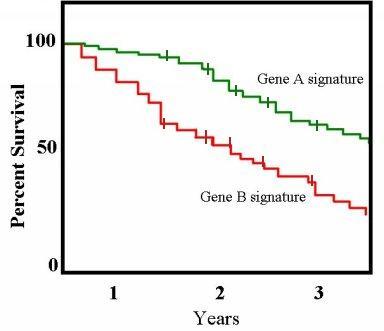Lifespan, survival, life expectancy, and longevity
Lifespan is typically defined as the period of time in which the life events of a species (or subspecies) typically occur.
Life expectancy is how long, on average, an animal can be expected to live from birth. Often, investigators use average lifespan and life expectancy interchangeably.
In the NIA and UW monkey studies, the investigators use median survival to compare calorie restricted (CR) groups to the control (CON) groups. Median survival is determined by Kaplan-Meier estimators, or plots (Figure 1).
Figure 1. A representative Kaplan-Meier survival plot. By Deanne Taylor (made and original to submitter) [Public domain], via Wikimedia Commons.
The term median survival (which is another way of saying it’s the time point when 50% of the monkeys have died, which is another way of saying median lifespan of this particular cohort) is what the investigators use to compare the lifespan of the cohorts at NIA and UW.
Longevity is typically defined as the period of time an organism is expected to live under ideal circumstances. In this case, the investigators would not only compare the CR cohort to the CON cohort, they may compare both the reported median (~ 27 years) and maximum (~ 40 years) lifespan of rhesus monkeys in captivity to the rhesus monkeys in their study.
The impact of CR on longevity was not considered as a primary outcome in either study (the UW or NIA). The investigators didn’t believe they would have the statistical power required to detect CR’s effect on longevity (Mattison et al., 2017).
Maximum lifespan is typically defined as the maximum period of time organisms of a given species (or subspecies) can live, which usually refers to the longevity of the longest-lived individual of that given species (or subspecies). For example, Jeanne Calment single-handedly set the maximum lifespan for humans at 122.45 years in this context. Note that maximum lifespan is sometimes defined as the age of the oldest 10% of the population in the literature, not just the longest-lived individual.
If there’s one thing to remember about studies—or the media reporting studies—conveying information on lifespan and/or survival, is that it’s critical to understand if they’re talking about lifespan in the context of the species as a whole, or relative to a control group (or some other cohort). It’s not always clear: the terms are often confused and misused.







I’d like to see Peter discuss SARMS. The most popular ones S4, LGD-4033, MK-2866, RAD-140 & SR-9009 and the 3 non-SARMS that usually fall into the category. MK-677, YK-11 and GW501516. Most of all MK-677 since it seems to fall into Peter’s specialty, longevity via GH and IGF1 increases. Regards.
Agree
Gas he ever commented on sarms